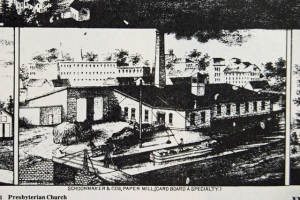By Art Cohn, Executive Director
In 2007 we had spent a night in Baldwinsville and hoped we would someday return to the Erie Canal and have an opportunity to open to the public here. The architecture of the town highlights the historic nature of the place and includes the re-purposed Red Mill Inn, the masonry hydro-power dam, and of course Lock 24 which dominates the town. This year is the celebration of 100 years of operation for that lock, with a Barge into Baldwinsville festival (happening this weekend!).
When we arrived into town I checked my 1824 French’s Gazetteer of New York State for some perspective and was surprised to read “Before the Erie Canal was made navigable, the navigation of its [Seneca River] waters was an object of great importance.” I had an opportunity to speak to Sue McManus, an events planner for Baldwinsville (and heavily involved with the Shacksboro Museum as well) and she informed me that the Old Erie Canal had not come through town; it was not until the 1910 completion of Lock 24, the first lock completed on the new Barge Canal, that the canal came directly through the center of Baldwinsville.

Sue was a great help in sorting it all out and she provided me with a “Birds Eye View of Baldwinsville from 1880” which indeed showed canal boats circumventing the dam in the center of town. This view suggested that there had been a canal through town but what relationship did it have to the Erie system? Sue told me about a booklet entitled Dr. Jonas C. and Mrs. Betsy Baldwin by George Hawley, which was out of print but which provided a perspective on this early Baldwinsville history and I was anxious to see if I could find a copy. Not to worry. Less than an hour later, Sue showed up with a complete Xerox copy for me. Not only was it another example of the spontaneous acts of kindness we experience aboard Lois, but it provided me with the perspective I was looking for on the maritime origins of the place. I am very grateful to Mr. Hawley, who was the Lysander town historian, for providing this perspective and to Sue for making this information available.

Since the time that Native Americans lived in this region, the intricate rivers and lakes of central New York provided transportation corridors. Jonas Baldwin’s family was from Massachusetts; his father fought for the Patriot side during the Revolutionary conflict. Jonas attended Williams College then medical school in Albany before landing a job as a physician to the Inland Lock Navigation Company, then struggling to build a canal to the west. Dr. Baldwin married Eliza Warner in 1792 and with her had seven children and several homes before moving to the place that would bear their name.
Dr. Baldwin was very much the entrepreneur. In 1809, one of his first initiatives upon moving to Baldwinsville was to purchase the local area rights to the defunct Inland Navigation Company and petition the State for permission to build a dam on the Seneca River to power mills. In conjunction with construction of the dam, Dr. Baldwin also requested permission to build a canal around the dam capable of handling vessels with a draft of up to two feet. Baldwin’s rights were to last for 20 years, with the possibility of extending them up through 1849.
After the Erie was opened in 1825, “it siphoned off most of the through-Seneca River traffic but the Baldwin Canal was vital to the Baldwinsville community”. In 1831 the canal was expanded to make it capable of handling the larger Erie boats then in operation. By then, Dr. and Mrs. Baldwin had passed away (within weeks of each other in 1827), and their sons were running the Baldwin empire. There was enough resistance to the continued Baldwin family domination of the dam and canal rights that a petition was submitted against its extension and the State took over the rights themselves.
In 1863 the State rebuilt the lock in stone. With the coming of the new Barge Canal, however, the old canal was eventually relegated to a raceway and in 1967 was filled in by the village.
With Sue’s assistance and the “Birds Eye View of 1880” in hand I found it possible to trace the route of the Baldwin Canal. Emerging onto Lock Street, I was able to reflect on the bygone days of Baldwinsville when this medical-man-turned-business-pioneer envisioned a community that would be dominated by water power and transportation. What a treat!
Art Cohn
Executive Director

Pingback: Notes from the Captain’s Log: Part Two | Lake Champlain Maritime Museum